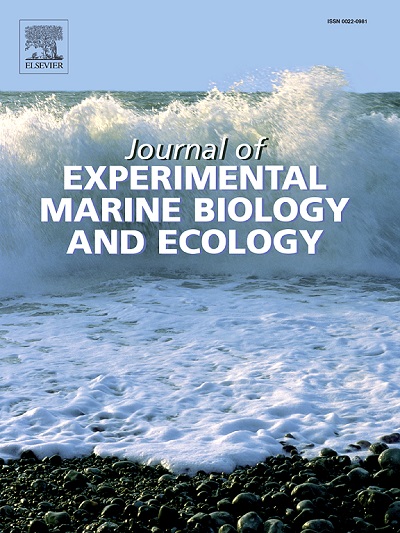Seasonality and hydroclimatic variability shape the functional and taxonomic diversity of nearshore fish communities in glacierized estuaries of Alaska
IF 1.8
3区 生物学
Q3 ECOLOGY
Journal of Experimental Marine Biology and Ecology
Pub Date : 2025-02-16
DOI:10.1016/j.jembe.2025.152086
引用次数: 0
Abstract
Nearshore fish communities in glacierized estuaries contend with environmental changes brought on by seasons and a shifting climate, which include alterations in freshwater runoff and environmental conditions shaped by the interplay of warming temperatures and receding glaciers. Spatial and temporal changes in environmental parameters can directly impact fish behavior and community structure, thereby affecting the dynamics of the entire ecosystem. Taxonomic diversity is commonly used to measure changes in communities, and while it offers important insights into community structure, considering the functional roles of organisms is necessary for understanding community dynamics through expressed traits and trophic interactions. Here, we evaluate the influence of environmental drivers on both taxonomic and functional diversity of fish communities at multiple sites in two glacially-influenced, high-latitude regions in the Gulf of Alaska (GoA): oceanic-influenced Kachemak Bay and the more typical estuarine Lynn Canal. Sites were analyzed monthly (April–September) for three years (2019, 2021, 2022) to address two questions: (1) Do taxonomic and functional diversity of nearshore fish communities show similar patterns of interannual and regional variation in glacially-influenced GoA estuaries? and (2) Do similar seasonal (i.e., monthly) and environmental (i.e., temperature, salinity, turbidity, freshwater discharge) drivers shape taxonomic and functional fish communities within these regions? Taxonomic and functional diversity were both significantly different between the two glacially-influenced GoA regions in all years. Environmental drivers of these patterns differed, but were weak across regional comparisons. Regional taxonomic composition was correlated to temperature, salinity, and turbidity while regional functional composition was not related to any environmental variables. Within regions, seasonality played a much stronger role in structuring Lynn Canal taxonomic and functional composition compared to Kachemak Bay where a stronger interannual signature was present. Taxonomic composition in Kachemak Bay was correlated with similar environmental variables to the regional comparison while Lynn Canal taxonomic composition was correlated to salinity and discharge. Both regions exhibited weak or non-existent relationships of functional composition to environmental drivers. In the more freshwater-influenced Lynn Canal, strong taxonomic and functional coupling across months indicates that seasonality structures communities, while in the more oceanic Kachemak Bay, weak seasonal differences and strong interannual differences indicate a system more influenced by oceanographic processes, as opposed to local changes.
季节性和水文气候变化塑造了阿拉斯加冰川河口近岸鱼类群落的功能和分类多样性
冰川河口的近岸鱼类群落面临着季节和气候变化带来的环境变化,其中包括淡水径流的变化,以及气温上升和冰川消退相互作用形成的环境条件。环境参数的时空变化可以直接影响鱼类的行为和群落结构,从而影响整个生态系统的动态。分类多样性通常用于衡量群落的变化,虽然它提供了对群落结构的重要见解,但考虑生物的功能角色对于通过表达性状和营养相互作用来理解群落动态是必要的。在这里,我们评估了环境驱动因素对阿拉斯加湾(GoA)两个受冰川影响的高纬度地区(海洋影响的Kachemak湾和更典型的林恩河口运河)多个地点鱼类群落分类和功能多样性的影响。对3年(2019年、2021年和2022年)每个月(4月至9月)的站点进行分析,以解决两个问题:(1)在受冰川影响的果阿邦河口,近岸鱼类群落的分类和功能多样性是否表现出类似的年际和区域变化模式?(2)相似的季节(如月度)和环境(如温度、盐度、浊度、淡水排放)驱动因素是否会影响这些地区的分类和功能鱼类群落?在所有年份,两个冰川影响的果阿地区之间的分类和功能多样性都存在显著差异。这些模式的环境驱动因素有所不同,但在区域比较中较弱。区域分类组成与温度、盐度和浊度相关,而区域功能组成与环境变量无关。在区域内,季节性在林恩运河的分类和功能组成中发挥了更大的作用,而Kachemak湾则存在更强的年际特征。Kachemak湾的分类组成与相似的环境变量相关,林恩运河的分类组成与盐度和流量相关。这两个地区的功能组成与环境驱动因素的关系不明显或不存在。在受淡水影响较大的林恩运河中,不同月份间较强的分类和功能耦合表明群落结构具有季节性;而在受海洋影响较大的Kachemak湾中,较弱的季节差异和较强的年际差异表明系统更受海洋学过程的影响,而不是局部变化。
本文章由计算机程序翻译,如有差异,请以英文原文为准。
求助全文
约1分钟内获得全文
求助全文
来源期刊
CiteScore
4.30
自引率
0.00%
发文量
98
审稿时长
14 weeks
期刊介绍:
The Journal of Experimental Marine Biology and Ecology provides a forum for experimental ecological research on marine organisms in relation to their environment. Topic areas include studies that focus on biochemistry, physiology, behavior, genetics, and ecological theory. The main emphasis of the Journal lies in hypothesis driven experimental work, both from the laboratory and the field. Natural experiments or descriptive studies that elucidate fundamental ecological processes are welcome. Submissions should have a broad ecological framework beyond the specific study organism or geographic region.
Short communications that highlight emerging issues and exciting discoveries within five printed pages will receive a rapid turnaround. Papers describing important new analytical, computational, experimental and theoretical techniques and methods are encouraged and will be highlighted as Methodological Advances. We welcome proposals for Review Papers synthesizing a specific field within marine ecology. Finally, the journal aims to publish Special Issues at regular intervals synthesizing a particular field of marine science. All printed papers undergo a peer review process before being accepted and will receive a first decision within three months.

 求助内容:
求助内容: 应助结果提醒方式:
应助结果提醒方式:


